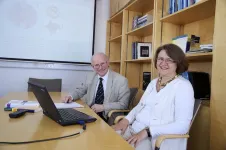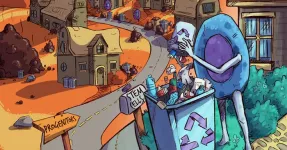(Press-News.org) A new nano-barrier coating could help protect ultra-lightweight carbon composite materials from extreme conditions in space, according to a study from the University of Surrey and Airbus Defence and Space.
The new functionality added to previously developed ‘space skin’ structures adds a layer of protection to help maintain space payloads while travelling in space, similar to having its very own robust ultralight protective jacket.
The research team has shown that their innovative nano-barrier would help drastically increase the stability of carbon fibre materials, while reducing radiation damage.
Professor Ravi Silva, corresponding author of the study and Director of the Advanced Technology Institute (ATI) at the University of Surrey, said:
"Current aluminium shielding is not thermally stable or fully conformal, and therefore usually undesired for stable structures. Not to mention that aluminium shielding contributes to the mass and cost of satellites. Our nano-barrier addresses these issues and is a promising upgrade to the industry standard which could become a key accessory to all space and aircraft structures that are both mobile and static.”
The coating is a highly dense superlattice structure applied to carbon fibre materials at room temperature which does not add over 1 μm of thickness, therefore keeping the materials lightweight.
The study has been published in Science Advances.
###
Notes to editors
Professor Ravi Silva is available for interview upon request.
For more information, please contact the University of Surrey’s press office via mediarelations@surrey.ac.uk
END
Ultra-lightweight multifunctional space skin created to withstand extreme conditions in space
2023-03-21
ELSE PRESS RELEASES FROM THIS DATE:
Researchers identify new genes that modulate the toxicity of the protein β-amyloid, responsible for causing Alzheimer’s disease
2023-03-21
An international study led by the Molecular Physiology Laboratory at the UPF Department of Medicine and Life Sciences (MELIS) identifies new genes that modulate the toxicity of the protein β-amyloid, responsible for causing Alzheimer’s disease. Combining molecular biology, genomics and bioinformatics techniques, 238 amyloid toxicity protective or activator genes have been identified. Among them, the gene Surf4 stands out. It is involved in the control of intracellular calcium and, by increasing the toxicity of the β-amyloid protein, contributes to the disease.
The research has been carried out thanks to the support ...
Smart light traps
2023-03-21
Plants use photosynthesis to harvest energy from sunlight. Now researchers at the Technical University of Munich (TUM) have applied this principle as the basis for developing new sustainable processes which in the future may produce syngas (synthetic gas) for the large-scale chemical industry and be able to charge batteries.
Syngas, a mixture of carbon monoxide and hydrogen, is an important intermediate product in the manufacture of many chemical starter materials such as ammonia, methanol and synthetic hydrocarbon fuels. "Syngas is currently made almost exclusively using fossil raw materials," ...
Visualization of electron dynamics on liquid helium for the first time
2023-03-21
An international team led by Lancaster University has discovered how electrons can slither rapidly to-and-fro across a quantum surface when driven by external forces.
The research, published in Physical Review B, has enabled the visualisation of the motion of electrons on liquid helium for the first time.
The experiments, carried out in Riken, Japan, by Kostyantyn Nasyedkin (now at Oak Ridge National Laboratory, USA) in the lab of Kimitoshi Kono (now in Taiwan at Yang Ming Chiao Tung University) detected unusual oscillations whose frequencies varied in time. Although it was unclear how ...
Argonne is helping U.S. companies advance battery recycling technology and strengthen the nation’s battery supply chain
2023-03-21
Argonne received $3.5 million in funding to help accelerate battery production in America, lower costs, provide a domestic source of materials and reduce the environmental impact of electric vehicle batteries.
Batteries are critical to powering a clean energy economy. This is especially true in the transportation sector, where electric vehicles (EVs) are on track to make up half of all new vehicle sales by 2030. In order to meet this rapidly increasing demand, the U.S. Department of Energy (DOE) is distributing funding to advance domestic recycling and reuse of electric vehicle batteries. Managed by DOE’s Vehicle ...
Machine learning programs predict risk of death based on results from routine hospital tests
2023-03-21
If you’ve ever been admitted to hospital or visited an emergency department, you’ve likely had an electrocardiogram, or ECG, a standard test involving tiny electrodes taped to your chest that checks your heart’s rhythm and electrical activity.
Hospital ECGs are usually read by a doctor or nurse at your bedside, but now researchers are using artificial intelligence to glean even more information from those results to improve your care and the health-care system all at once.
In recently published findings, the research team built and trained machine learning programs based on 1.6 ...
Imaging the proton with neutrinos
2023-03-21
The Science
Protons and neutrons, the building blocks of atomic nuclei, are themselves made up of strongly interacting quarks and gluons">quarks and gluons. Because the interactions are so strong, the structure of protons and neutrons is difficult to calculate from theory. Instead, scientists must measure it experimentally. Neutrino experiments use targets that are nuclei made of many protons and neutrons bound together. This complicates interpreting those measurements to infer proton structure. ...
To ward off aging, stem cells must take out the trash
2023-03-21
In humanity’s ongoing quest for the elixir of life, the science keeps pointing to stem cells. Research increasingly shows that maintaining stem cell fitness promotes a long healthspan, and new findings show keeping stem cells clean and tidy is an integral step.
In a study published March 21, 2023 in Cell Stem Cell, researchers at University of California San Diego School of Medicine found that blood stem cells use an unexpected method to get rid of their misfolded proteins, and that this pathway’s ...
Uracil found in Ryugu samples
2023-03-21
Samples from the asteroid Ryugu collected by the Hayabusa2 mission contain nitrogenous organic compounds, including the nucleobase uracil, which is a part of RNA.
Researchers have analyzed samples of asteroid Ryugu collected by the Japanese Space Agency’s Hayabusa2 spacecraft and found uracil—one of the informational units that make up RNA, the molecules that contain the instructions for how to build and operate living organisms. Nicotinic acid, also known as Vitamin B3 or niacin, which is an important cofactor for metabolism in living organisms, was also detected in the same samples.
This discovery by an international team, led by Associate Professor ...
Honey, the 3D print--I mean, dessert--is ready!
2023-03-21
New York, NY—March 21, 2023—Cooking devices that incorporate three-dimensional (3D) printers, lasers, or other software-driven processes may soon replace conventional cooking appliances such as ovens, stovetops, and microwaves. But will people want to use a 3D printer--even one as beautifully designed as a high-end coffee maker--on their kitchen counters to calibrate the exact micro- and macro-nutrients they need to stay healthy? Will 3D food printing improve the ways we nourish ourselves? What sorts of ...
Albert Einstein College of Medicine and Montefiore Health System awarded $30 million from NIH to support its Institute for Clinical and Translational Research
2023-03-21
March 21, 2023—BRONX, NY—Albert Einstein College of Medicine and Montefiore Health System have received a seven-year, $30 million grant from the National Institutes of Health (NIH) to continue support for the Harold and Muriel Block Institute for Clinical and Translational Research at Einstein and Montefiore (ICTR). The latest Clinical and Translational Science Award (CTSA) will ensure the ICTR will further its vision to improve health in the Bronx, Westchester, and lower Hudson Valley by accelerating the translation of scientific discoveries into effective and equitable prevention and treatment approaches.
“Since establishing ...






